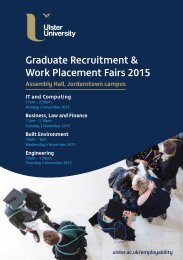Public Attitudes to Peace Walls (2015)
1RRkqqy
1RRkqqy
You also want an ePaper? Increase the reach of your titles
YUMPU automatically turns print PDFs into web optimized ePapers that Google loves.
<strong>Public</strong> <strong>Attitudes</strong> <strong>to</strong> <strong>Peace</strong> <strong>Walls</strong> (<strong>2015</strong>)<br />
Survey Results<br />
Ulster University<br />
Table 19: Who do you think wants the <strong>Peace</strong> Wall in your community <strong>to</strong> stay or go? (want it removed)<br />
Total (%) Protestant (%) Catholic (%)<br />
You personally 36 24 41<br />
Most local people from this community 18 11 23<br />
Most local people from the neighbouring community 15 13 16<br />
Local Council 39 40 40<br />
The Office of the First Minister and Deputy First Minister 49 50 49<br />
The Department of Justice 40 37 42<br />
The PSNI 19 17 21<br />
The definition of ‘community consent’ remains vague and so this survey sought <strong>to</strong> gather some<br />
initial perceptions from residents as <strong>to</strong> what community consent, meant <strong>to</strong> them (Table 20). The<br />
findings show that the largest proportion (38%), especially among Protestants (45%), believe that<br />
community consent means that ‘everybody in the community’ agrees with the decision. How<br />
such community consent could be achieved within an entire community without creating the<br />
opportunity for specific ve<strong>to</strong>es is problematic.<br />
Table 20: What does community consent mean <strong>to</strong> you?<br />
Total (%) Protestant (%) Catholic (%)<br />
Everybody in the community<br />
agrees with the decision<br />
50+1% of people in the<br />
community agree with a decision<br />
A decision is made by those most<br />
closely affected by a proposal<br />
A decision is made by locally<br />
elected political representatives<br />
A decision is made by local<br />
community leaders<br />
38 45 36<br />
26 20 26<br />
25 23 28<br />
3 3 3<br />
6 6 5<br />
Recent research by Bell and Young (2013) highlights the complexities that surround developing<br />
a model of consultation and reinforces the idea that one aspect of effective consultation is <strong>to</strong><br />
develop local knowledge <strong>to</strong> increase levels of engagement and create more informed decisions<br />
around options for regenerating or transforming interface communities. The challenge for those<br />
tasked with meeting the 2023 target is <strong>to</strong> ensure that local residents feel included in any process,<br />
have been consulted on proposed changes, and are aware of the implications of the policy.<br />
20




